Mar 16
Posted: under Activities, Plantlife, Water, Weather.
Tags: beauty, observation, photography, water resource management, Weather March 16th, 2009
Plants around here take immediate advantage of water, so the change in color after less than a week from the first drop of rain is striking. Not only does green show on the mowed maintenance path, but at the base of the taller clumps to either side. Rain started Wednesday; this was taken Sunday. Last […] [...more]
Plants around here take immediate advantage of water, so the change in color after less than a week from the first drop of rain is striking.
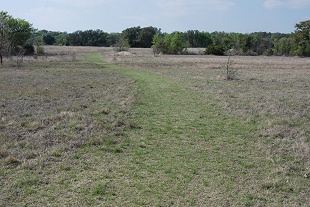
Near Meadow
Not only does green show on the mowed maintenance path, but at the base of the taller clumps to either side. Rain started Wednesday; this was taken Sunday. Last week, no green.
Read the rest of this entry »

Mar 09
Posted: under photography, Plantlife, Wildlife.
Tags: beauty, native plants, photography, wildlife management March 9th, 2009
We saw a Luna Moth again today. It might have been the same one or another one. This was in the mid-morning of a cloudy day, with a strong wind from the S (the other side of the fence. The white “frosting” on the forewing purple stripe is (when really enlarged) white scales mixed with […] [...more]
We saw a Luna Moth again today. It might have been the same one or another one. This was in the mid-morning of a cloudy day, with a strong wind from the S (the other side of the fence.
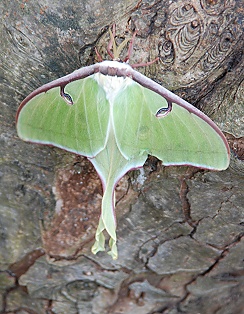
Luna Moth
The white “frosting” on the forewing purple stripe is (when really enlarged) white scales mixed with the purplish ones. You can just see the underwing eyespots showing through.
Read the rest of this entry »

Mar 04
Posted: under Land, Plantlife, Weather, Wildlife.
Tags: beauty, native plants, photography, Weather, wildlife management March 4th, 2009
Even in a year this dry, some of the native plants (and a few non-natives) do their best to keep alive and growing. One of the natives we’ve nurtured for years in the yard is the scarlet buckeye, an understory tree that hates sun and drought–but thrives in shady canyons near permanent water. Our version […] [...more]
Even in a year this dry, some of the native plants (and a few non-natives) do their best to keep alive and growing.
One of the natives we’ve nurtured for years in the yard is the scarlet buckeye, an understory tree that hates sun and drought–but thrives in shady canyons near permanent water. Our version of that is the shade of a big old ash and regular watering. I’d like to move its progeny into the creek woods, but right now they’re far too dry (and too far away to water.) It’s just showing its flower buds now; they’ll be open in a few days.
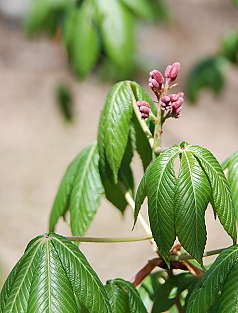
Read the rest of this entry »

Feb 26
Posted: under photography, Plantlife, Wildlife.
Tags: Animal behavior, beauty, native plants, photography February 26th, 2009
Mexican plum, the tree-sized wild plum around here, blooms even in drought years. Not only is it snowy white and beautiful, it has that amazing wild-plum fragrance…and as it’s an early bloomer, it attracts everything that’s hungry for nectar. It doesn’t look like this long–especially in a drought year–and the tiny white petals are already […] [...more]
Mexican plum, the tree-sized wild plum around here, blooms even in drought years. Not only is it snowy white and beautiful, it has that amazing wild-plum fragrance…and as it’s an early bloomer, it attracts everything that’s hungry for nectar.
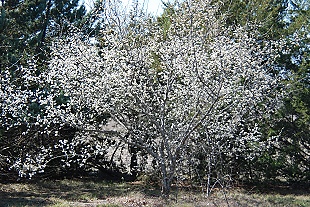
Mexican Plum in full bloom
It doesn’t look like this long–especially in a drought year–and the tiny white petals are already blowing off it in today’s stiff warm breeze.
Read the rest of this entry »

Feb 13
Posted: under Activities, photography, Plantlife.
Tags: Activities, drought, photography February 13th, 2009
Even in a dry year, spring comes early to central Texas. I’m recovering from pneumonia so can’t get out to the full 80 acres, but here are some pictures from around the house. (I need to plant some elbowbush up by the house, as it’s one of the very earliest.) Rusty blackhaw viburnum is one […] [...more]
Even in a dry year, spring comes early to central Texas. I’m recovering from pneumonia so can’t get out to the full 80 acres, but here are some pictures from around the house. (I need to plant some elbowbush up by the house, as it’s one of the very earliest.)
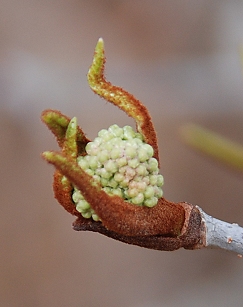
Rusty Blackhaw Viburnum bud
Rusty blackhaw viburnum is one of the most beautiful of the native shrubs, but it’s routinely scraped off by developers as “brush”. Here, the buds are just opening to show the bud-cluster that will be a puffball of pure white within a week. Easy to see why it acquired the name “rusty.” It’s a valuable plant for wildlife, producing tasty blue berries for birds–and nectar for the early butterflies and moths.
Read the rest of this entry »

Jan 18
Posted: under Activities, photography, Plantlife, Wildlife.
Tags: Activities, photography, wildlife management January 18th, 2009
Yesterday was the “nose to the grindstone” day for putting the annual report in final form, including choosing which pictures to include to show the story of the year on our place. The official form has nine pages. Add to that a cover sheet with our names and other useful information the form itself doesn’t […] [...more]
Yesterday was the “nose to the grindstone” day for putting the annual report in final form, including choosing which pictures to include to show the story of the year on our place.
The official form has nine pages. Add to that a cover sheet with our names and other useful information the form itself doesn’t have space for, and three pages of supplementary notes referencing specific points of the form (which, for instance, does not have a check-box for “check-dams/gabions” under “erosion control”–just ponds, dykes, and levees, so I have to add a note about our check-dams and gabions every year) , and then 14 pages that I call the Activity Report, detailing (well, outlining, but in more detail than their Annual Report Form makes possible) the activities we’ve done in each of the seven management areas with (where possible) photographs.
(Photos beyond the break)
Read the rest of this entry »

Jan 12
Posted: under Activities, Plantlife, Wildlife.
Tags: Activities, Animal behavior, beauty, observation, photography, supplemental feeding, wildlife management January 12th, 2009
Today’s wildlife experience was an armadillo, drinking noisily (they slurp, sounding rather like dogs) from the overflow guzzler at Fox Pavilion when we came back around that way after a long, two-hour stroll around the place. I thought I’d turned the water off completely, but some grit must’ve been in the faucet, because the water […] [...more]
Today’s wildlife experience was an armadillo, drinking noisily (they slurp, sounding rather like dogs) from the overflow guzzler at Fox Pavilion when we came back around that way after a long, two-hour stroll around the place. I thought I’d turned the water off completely, but some grit must’ve been in the faucet, because the water had overflowed.
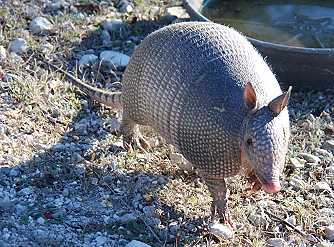
Read the rest of this entry »

Dec 14
Posted: under Land, Plantlife.
Tags: success December 14th, 2008
This is an experiment, in part. We had a lovely display down the drive again this year–something I planted for, years back–and I’m going to try to insert an image file into this post. We shall see if it works…hmmmnot this time. Edited: trying again. And Lo! The magic worked and the picture appeared. Hurray! [...more]
This is an experiment, in part. We had a lovely display down the drive again this year–something I planted for, years back–and I’m going to try to insert an image file into this post. We shall see if it works…hmmmnot this time.
Edited: trying again.
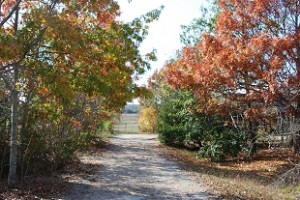
December Driveway
And Lo! The magic worked and the picture appeared. Hurray!

Dec 09
Posted: under Land, Plantlife.
Tags: beauty, trees December 9th, 2008
A norther blew in this afternoon, so we have blue sky and sunshine–and the red oaks near the house are the reddest they’ve ever been, brilliant in the slanting light. Most of these started as acorns collected from other oaks whose color we’d noted while driving around the countryside. Then we’d watch until “red oak […] [...more]
A norther blew in this afternoon, so we have blue sky and sunshine–and the red oaks near the house are the reddest they’ve ever been, brilliant in the slanting light.
Most of these started as acorns collected from other oaks whose color we’d noted while driving around the countryside. Then we’d watch until “red oak acorn season” and see if any had fallen on a roadside verge where it would be legal to collect them. They’re not all the same–some a deep, deep red and others more scarlet or even orange-red.
The ones nearest the house have had some supplemental water (when the town’s not on water restriction, which it is right now) and are larger and more colorful than the ones we’ve put out on the land here and there. Red oaks are more subject to the local oak diseases than bur oaks, but it’s worth the risk of losing them to have this glorious late fall/early winter color.
Of course, they’re also a great wildlife resource–acorns for deer and wild turkey, nest sites for some songbirds, and plenty of insects for the little insect-eaters to go after. Thirty years ago, late November into December showed the hillsides in dark green (live oak and juniper) and varied shades of red from red oaks, but about ten years ago one of the diseases killed many of them. Oldtimers say it happened before and new oaks grew up. Maybe by planting acorns every year (even if replanted by squirrels) we’ll eventually get more out on the land.








